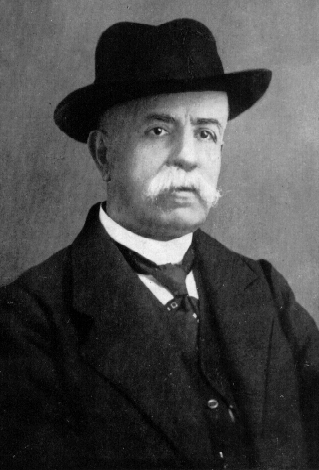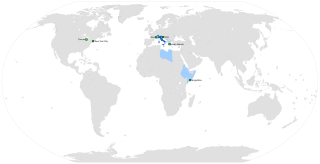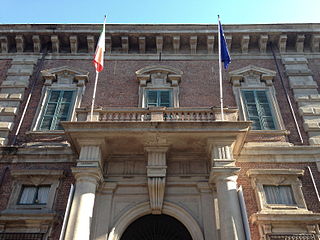Related Research Articles
The Accademia dei Lincei, anglicised as the Lincean Academy, is one of the oldest and most prestigious European scientific institutions, located at the Palazzo Corsini on the Via della Lungara in Rome, Italy. Founded in the Papal States in 1603 by Federico Cesi, the academy was named after the lynx, an animal whose sharp vision symbolizes the observational prowess that science requires. Galileo Galilei was the intellectual centre of the academy and adopted "Galileo Galilei Linceo" as his signature. "The Lincei did not long survive the death in 1630 of Cesi, its founder and patron", and "disappeared in 1651."

A learned society is an organization that exists to promote an academic discipline, profession, or a group of related disciplines such as the arts and sciences. Membership may be open to all, may require possession of some qualification, or may be an honour conferred by election.

Gregorio Ricci-Curbastro was an Italian mathematician. He is most famous as the discoverer of tensor calculus.

The Accademia della Crusca, generally abbreviated as La Crusca, is a Florence-based society of scholars of Italian linguistics and philology. It is one of the most important research institutions of the Italian language, as well as the oldest linguistic academy in the world.

The Accademia di Belle Arti di Firenze is the oldest public institution of fine arts training in the world. Founded in 1563 by Cosimo I de' Medici under the influence of Giorgio Vasari, it was subsequently reorganized at the initiative of the Grand Duke of Tuscany and separated from the Accademia delle Arti del Disegno in 1784. Michelangelo, Benvenuto Cellini and other significant artists have been associated with it. Like other state art academies in Italy, it became an autonomous degree-awarding institution under law no. 508 dated 21 December 1999, and falls under the administration of the Ministero dell'Istruzione, dell'Università e della Ricerca, the Italian ministry of education and research. The adjacent Galleria dell'Accademia houses the original David by Michelangelo.

The Gallerie dell'Accademia is a museum gallery of pre-19th-century art in Venice, northern Italy. It is housed in the Scuola della Carità on the south bank of the Grand Canal, within the sestiere of Dorsoduro. It was originally the gallery of the Accademia di Belle Arti di Venezia, the art academy of Venice, from which it became independent in 1879, and for which the Ponte dell'Accademia and the Accademia boat landing station for the vaporetto water bus are named. The two institutions remained in the same building until 2004, when the art school moved to the Ospedale degli Incurabili.
A pontifical academy is an academic honorary society established by or under the direction of the Holy See. Some were in existence well before they were accepted as "Pontifical."

The Accademia Carrara,, officially Accademia Carrara di Belle Arti di Bergamo, is an art gallery and an academy of fine arts in Bergamo, in Lombardy in northern Italy. The art gallery was established in about 1780 by Giacomo Carrara, a Bergamasco collector or conoscitore of the arts. The academy of fine arts was added to it in 1794. The school was recognised by the Ministero dell'Istruzione, dell'Università e della Ricerca, the Italian ministry of education, in 1988 and in 2023 merged with the Conservatorio Gaetano Donizetti to form the Politecnico delle Arti di Bergamo.

The Accademia Nazionale di Santa Cecilia is one of the oldest musical institutions in the world, founded by the papal bull Ratione congruit, issued by Sixtus V in 1585, which invoked two saints prominent in Western musical history: Gregory the Great, for whom the Gregorian chant is named, and Saint Cecilia, the patron saint of music. Since 2005 it has been headquartered at the Renzo Piano designed Parco della Musica in Rome.
The Orchestra dell'Accademia Nazionale di Santa Cecilia is an Italian symphony orchestra based in Rome. Resident at the Parco della Musica, the orchestra primarily performs its Rome concerts in the Sala Santa Cecilia.

The Accademia di Belle Arti di Bologna is a public tertiary academy of fine art in Bologna, in Emilia-Romagna in northern Italy. It has a campus in Cesena.

The Accademia di Belle Arti di Brera, also known as the Accademia di Brera or Brera Academy, is a state-run tertiary public academy of fine arts in Milan, Italy. It shares its history, and its main building, with the Pinacoteca di Brera, Milan's main public museum for art. In 2010 an agreement was signed to move the accademia to a former military barracks, the Caserma Magenta in via Mascheroni. In 2018 it was announced that Caserma Magenta was no longer a viable option, with the former railway yard in Via Farini now under consideration as a potential venue for the campus extension.
The Nuova Accademia di Belle Arti, "New Academy of Fine Arts", also known as NABA, is a private academy of fine art in Milan, in Lombardy in northern Italy. It has approximately 3000 students, some of whom are from abroad; it participates in the Erasmus Programme.

The Accademia delle Arti del Disegno is an academy of artists in Florence, in Italy. It was founded on 13 January 1563 by Cosimo I de' Medici, under the influence of Giorgio Vasari. It was initially known as the Accademia e Compagnia delle Arti del Disegno and consisted of two parts: the company was a kind of guild for all working artists, while the academy was for more eminent artistic figures of the Medici court, and supervised artistic production in the Duchy of Florence.

The Italian Naval Academy is a coeducational military university in Livorno, which is responsible for the technical training of military officers of the Italian Navy.
The Accademia degli Incamminati was one of the first art academies in Italy, founded in 1582 in Bologna.
Giorgio Baldizzone is an Italian entomologist who specialises in the study of Microlepidoptera, in particular the family Coleophoridae. Baldizzone is a past president of the Piedmonte and Valle d’Aosta chapter of the World Wide Fund for Nature.

The Accademia di Belle Arti di Roma is a public tertiary academy of art in Rome, Italy. It was founded in the sixteenth century, but the present institution dates from the time of the unification of Italy and the capture of Rome by the Kingdom of Italy in 1870.
Giovanni Antonelli was an Italian archivist, historian and politician.
References
- ↑ "The Theater that was Rome – Biography". library.brown.edu. Retrieved 2024-03-22.